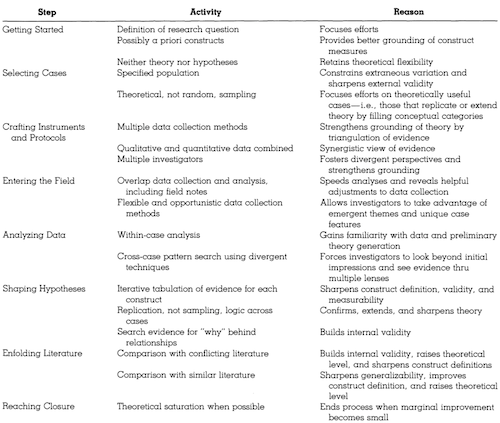Case Study Research for Theory Creation
How is new knowledge generated in the social sciences? One method is case study research.
Case Study
A case study is an in-depth investigation of a specific question regarding an individual research object, it can be differentiated using the following criteria:
- Number of objects investigated: single / multiple cases
- Number of levels of analysis: embedded design
- Data collection: used data collection methods (eg. interviews, written files,…)
- Kind of data ascertained: qualitative / quantitative
- Purpose of the study: provide description / test theory / generate theory
Theory development
Theories are usually developed using observations (Newton’s Apple), using grounded theory, or by analyzing qualitative data. This article shows how case research can be used for the development of theories as well.
Process of Building Theory from Case Study Research

- Selecting cases
Instead of random sampling used in surveys, where statistical significance is important, cases should be selected using theoretical sampling, to focus efforts on useful cases
- Data collection
Triangulation is used here to analyzing the object from different angles, eg. using data from interviews, company presentations and publicly available data.
- Data analysis
The analysis of the data should happen as soon as possible, in contrast to surveys where the questionnaire does not change during execution, case research should adapt to the results of previous findings.
Eisenhardt (1989) further lists the following advantages / factors when to use case research.
Strength:
- Higher likelihood of generating novel theory
- Emergent theory is likely to be testable with constructs that can be readily measured and hypotheses that can be proven false
- Resultant theory is likely to be empirically valid
Weakness:
- Empirical evidence can yield theory which is overly complex
- The result may be a narrow and idiosyncratic theory
Applicability:
- When little is known about a phenomenon
- Current perspectives seem inadequate
- Current opinion conflict with each other or common sense
Conclusion
Case studies cannot support a theory with statistical relevant findings, but case studies are turned into theories by finding common patterns within the gathered data. After this step further support will be needed to establish the validity of the theory, which can be using modeling approaches or statistically significant surveys.
Eisenhardt, K. (1989). Building Theories from Case Study Research The Academy of Management Review, 14 (4) DOI: 10.2307/258557








Add new comment